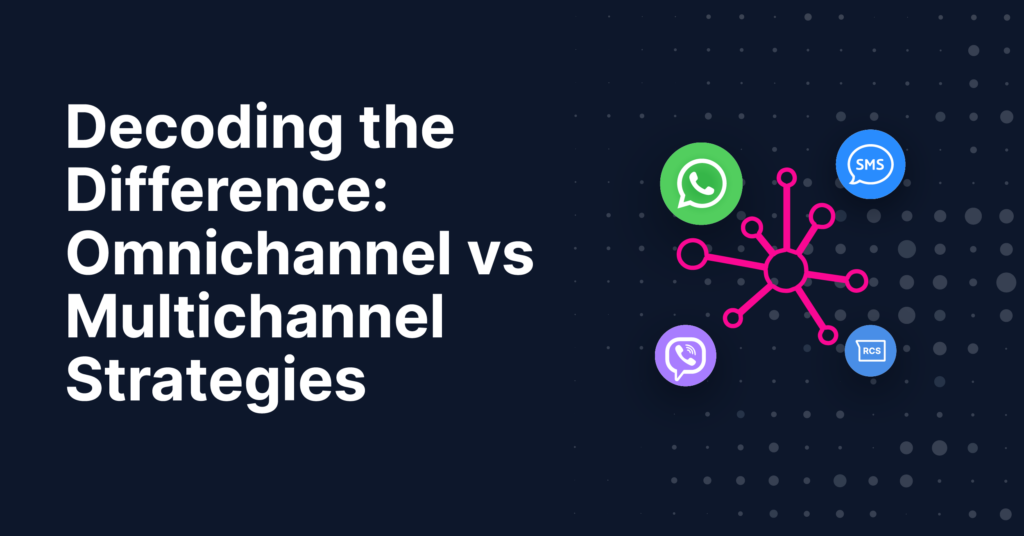Omnichannel vs multichannel strategies are at the forefront of shaping today’s customer experience landscape, each offering a unique approach to engaging and retaining customers.
This article delves into the nuances of both strategies, highlighting their definitions, key differences, and the impact they have on customer satisfaction and business success.
You will gain an understanding of how these strategies work, their advantages and challenges, and the role they play in modern business communication.
Through this exploration, businesses can better decide which approach aligns with their goals, ensuring a seamless and enriched customer journey.
1. Overview: Digital Customer Engagement Strategies
In the digital age, customer engagement strategies have undergone significant evolution, adapting to the rise of online platforms and the increasing demand for personalized interactions.
This era is characterized by the shift from traditional, linear engagement methods to more dynamic, technology-driven approaches.
Among these, omnichannel and multichannel strategies stand out, offering businesses innovative ways to connect with customers across multiple touchpoints.
This overview explores how these strategies have become essential in delivering a cohesive and customized experience to the digitally savvy consumer, setting the stage for enhanced satisfaction and loyalty in today’s competitive marketplace.
2. Understanding Multichannel Strategies
Multichannel strategies involve engaging customers through various independent channels, such as social media, email, retail stores, and websites, without integrating these interactions.
This approach allows businesses to reach a wider audience by being present on multiple platforms where their customers are active.
-
Key Characteristics:
- Diverse Channels: Utilizes a variety of platforms to connect with customers.
- Independent Operations: Each channel operates separately, with its own strategy and goals.
- Broad Reach: Aims to maximize visibility and accessibility across different customer segments.
-
Advantages:
- Increased Reach: Being present on multiple platforms enhances the visibility of the business.
- Customer Preference: Allows customers to choose their preferred channel of interaction.
- Flexibility: Businesses can test different channels and adapt based on performance.
-
Challenges:
- Consistency: Maintaining a consistent brand message across all channels can be difficult.
- Integration: Lack of integration can lead to disjointed customer experiences.
- Resource Intensive: Requires significant resources to manage and optimize each channel effectively.
Multichannel strategies offer the benefit of broad engagement but come with challenges in creating a cohesive customer experience.
3. Exploring Omnichannel Strategies
Omnichannel strategies integrate various communication and sales channels to provide a seamless and unified customer experience, regardless of how or where a customer reaches out.
This approach centers on creating a cohesive customer journey that smoothly transitions between online and offline channels.
-
Key Characteristics:
- Integration: Harmonizes all channels to function cohesively, sharing data and insights across platforms.
- Customer-Centric: Focuses on delivering a consistent, personalized experience tailored to individual customer preferences and history.
- Seamless Transition: Enables customers to switch between channels without disruption or loss of context.
-
Advantages:
- Enhanced Customer Experience: Delivers a seamless, personalized journey across all touchpoints, increasing satisfaction and loyalty.
- Increased Insights: Integrated channels provide valuable data on customer behavior, improving decision-making and personalization.
- Higher Efficiency: Unified systems streamline operations and reduce redundancies, saving time and resources.
-
Challenges:
- Complex Implementation: Requires sophisticated technology and strategy to seamlessly integrate all channels.
- Data Management: Involves handling large volumes of data securely and efficiently to ensure privacy and relevance.
- Consistent Execution: Maintaining a uniform experience across all channels demands continuous monitoring and adaptation.
Despite these challenges, by relying on a provider like Javna, businesses can overcome these obstacles.
Javna provides a seamless omnichannel communication experience, ensuring businesses can connect with their customers across various platforms and devices, effectively addressing the complexities of implementation, data management, and consistent execution.
4. Omnichannel vs Multichannel: The Key Differences
In today’s customer-centric market, understanding the nuances between omnichannel and multichannel strategies is crucial for crafting effective engagement models.
These strategies, while aiming to broaden customer reach, differ significantly in execution and impact on the customer experience. To elucidate these distinctions, the following table offers a clear comparison:
| Feature | Multichannel Strategy | Omnichannel Strategy |
| Approach | Engages customers across multiple, separate channels | Provides a cohesive experience across all channels |
| Customer Choice | Offers freedom in channel selection | Ensures consistency and personalization across choices |
| Operations | Channels operate independently | Integrated and unified channel operations |
| Experience | Can lead to disjointed experiences | Seamless and integrated customer journey |
| Data Use | Limited use of shared customer data across channels | Utilizes comprehensive data for personalized interactions |
This comparison highlights that the primary distinction lies in the integration and consistency of customer experiences, with omnichannel strategies focusing on a unified, data-driven approach versus the broader, less integrated approach of multichannel strategies.
You may also be interested in:
5. Statistics Highlighting the Importance of Omnichannel
Here are some statistics to help you understand the power of the Omnichannel approach that might be best for your business:
-
Omnichannel Drives Higher Order Rates:
Businesses that leverage three or more channels in their marketing campaigns see a significant advantage. An analysis by Omnisend revealed that omnichannel marketing strategies can lead to a 494% higher order rate compared to single-channel campaigns!
-
Increased Customer Satisfaction:
A study by Harvard Business Review found that customers who have consistent omnichannel experiences show a 33% higher customer lifetime value.
While multichannel strategies can still be effective, the trends and statistics highlight the growing importance of omnichannel approaches. Customers today expect a seamless and personalized experience across all touchpoints.
Businesses that prioritize creating a unified omnichannel experience are more likely to:
-
- Increase customer satisfaction and loyalty
- Improve customer engagement and brand perception
- Drive higher sales and conversions
-
Additional Considerations:
Implementing a successful omnichannel strategy requires careful planning and investment. Businesses need to consider:
-
- Customer journey mapping: Understanding how customers interact with your brand across various touchpoints.
- Data integration: Utilizing technology to ensure consistent customer data flows across all channels.
- Omnichannel marketing automation: Streamlining communication and personalized messaging across channels.
By focusing on these aspects, businesses can leverage the power of omnichannel marketing to create a customer-centric experience that drives success in today’s competitive landscape.
6. Choosing the Right Strategy for Your Business
Choosing the right strategy between omnichannel and multichannel for your business hinges on several critical factors, tailored to align with your business goals, understand customer needs, and assess technological capabilities:
-
-
Business Goals:
-
Define what you aim to achieve with your customer engagement strategy—whether it’s expanding market reach, enhancing customer loyalty, or improving operational efficiency.
-
-
Customer Needs and Expectations:
-
Consider your customers’ preferences for interaction and service. Omnichannel strategies may better suit businesses whose customers value a seamless experience across channels.
-
-
Technological Infrastructure:
-
Assess your current technological capabilities and readiness to integrate systems for an omnichannel strategy, or if a multichannel approach is more feasible given existing platforms.
-
-
Resource Availability:
-
Consider the resources, both financial and human, required to implement and manage the chosen strategy effectively.
-
-
Data Handling and Analytics:
-
Evaluate your capacity to collect, analyze, and utilize customer data to inform personalized experiences, a cornerstone of effective omnichannel strategies.
-
-
Competitive Landscape:
-
Analyze the strategies employed by competitors and the industry standard to ensure your approach aligns with market expectations and offers a competitive edge.
Understanding these factors will guide businesses in selecting the strategy that not only meets their current needs but also positions them for future growth and customer satisfaction.
7. Conclusion
In conclusion, the journey through omnichannel and multichannel strategies reveals distinct paths toward enhancing customer experience.
Multichannel strategies offer breadth, engaging customers across various platforms without interconnection, catering to those who value choice and presence. Conversely, omnichannel strategies emphasize depth, integrating all channels to deliver a seamless and personalized customer journey, reflecting the growing consumer demand for cohesive experiences.
Each approach bears unique advantages and challenges, with the choice between them depending on a business’s specific goals, customer expectations, and technological readiness.
Ultimately, understanding the nuances of each strategy allows businesses to make informed decisions, ensuring their communication efforts effectively foster customer engagement and satisfaction in today’s dynamic digital landscape.
8. FAQs about Omnichannel vs Multichannel
-
What is the difference between omnichannel and multichannel customer support?
The difference between omnichannel and multichannel customer support lies in integration and consistency.
Multichannel support engages customers across multiple, separate channels, allowing choice but potentially leading to disjointed experiences. Omnichannel support, however, integrates all channels to provide a seamless, consistent customer experience, ensuring smooth transitions and personalized interactions regardless of the chosen platform.
-
What is an example of omnichannel?
An example of omnichannel is a retail experience where a customer can browse products on a company’s website, place an item in their online shopping cart, receive personalized recommendations via email, then complete the purchase in-store. Throughout this journey, their experience is seamless and consistent, with each interaction informed by their previous engagements across the brand’s channels.
-
Who needs omnichannel?
Businesses aiming to provide a seamless, integrated customer experience across multiple platforms and touchpoints need omnichannel strategies.
This approach is particularly beneficial for sectors like retail, banking, healthcare, and telecommunications, where customer engagement and satisfaction are crucial for loyalty and retention.
-
Is omnichannel only digital?
No, omnichannel is not only digital. It integrates both digital and physical channels, such as websites, mobile apps, social media, and brick-and-mortar stores, to create a cohesive customer experience across all platforms and touchpoints.



